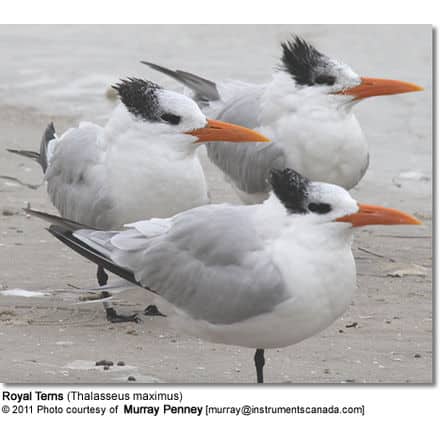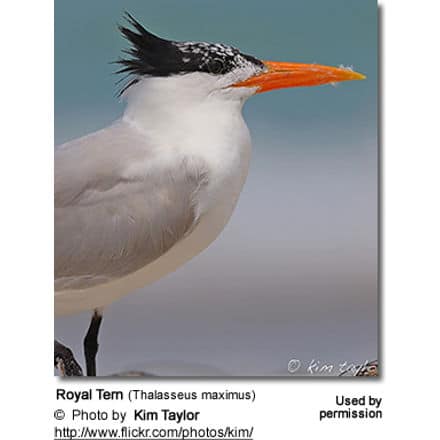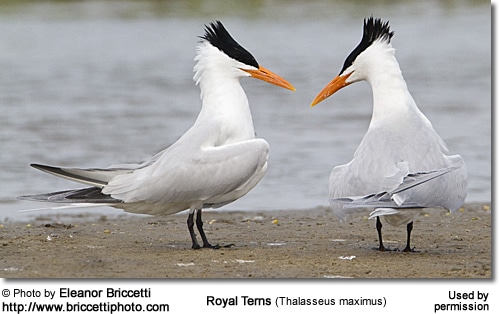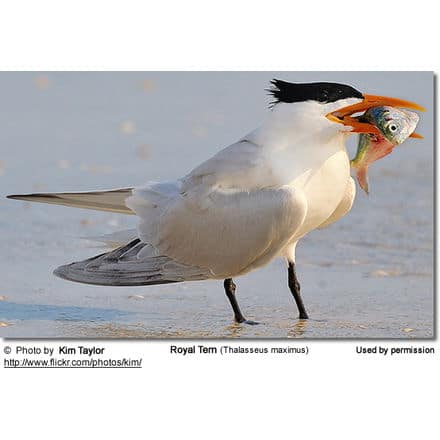Royal Terns
The Royal Terns (Thalasseus maximus) is the second-largest tern (the largest being the Caspian Tern). In gatherings of gulls and terns, it is usually quite easily identified by its larger size, its distinctive black crest, and bright orange bill.
This common seabird is found along many tropical and subtropical shores of the Americas and West Africa.
A group of Royal Terns is collectively known as “Highness”.
The oldest recorded Royal Tern was 30+ years old. This tern was banded in 1983 in North Carolina, USA, and in December 2013, it was found badly injured in Belize by a member of the public and delivered to Nikki Buxton of the Belize Bird Rescue. Sadly, despite best efforts, this bird succumbed shortly afterward.
Alternate (Global) Names)
Afrikaans: Koningseeswael , Koningsterretjie … Chinese: ?????? … Czech: Rybák královský … Danish: Kongeterne … Dutch: Koningsstern … German: Königseeschwalbe, Königsseeschwalbe, Königs-Seeschwalbe … Spanish: charrán rael, Charrán Real, Gaviota golondrina real, Gaviota Real, Gaviotín Real, Golondrina-marina Real, Pagaza Real … Finnish: Kuningastiira … French: Sterne royale … Hebrew: ????? ????? … Icelandic: Rosaþerna … Italian: Sterna reale … Japanese: amerikaooajisashi … Norwegian: Kongeterne … Polish: rybitwa królewska … Portuguese: andorinha-do-mar, Gaivina-real, gaivota-de-cabeça-preta, Garajau-real, Tinhosa, trinta-réis, trinta-réis-grande, Trinta-réis-real … Russian: ??????????? ?????? … Slovak: Rybár král’ovský, rybár velký … Slovenian: kraljeva ?igra … Swedish: Kungstärna … Turkish: Kral Sumru


Subspecies / Distribution and ID:
- Thalasseus maximus maximus (Boddaert, 1783) ( syn. Sterna maxima – see Bridge et al., 2005) – Nominate Race
- They breed along the Atlantic coast in southern California to Sinaloa, at the Golf coast in Texas, and along the Atlantic coasts in Maryland south to, Mexico, the West Indies, and the Guianas; possibly also Brazil. Disjunct breeding populations exist on Yucatán and in southern Brazil, Uruguay, and northern Patagonia. In California, they are more common in winter than in summer. In North America, the Royal Tern is found along coasts, around sandy beaches, and in bays, lagoons, and estuaries. In North America, they are rarely found inland – except for a few localities in Florida. In the Caribbean, they frequently travel between islands.
- They migrate south to winter in Peru, Uruguay and Argentina
- Thalasseus maximus albididorsalis (Hartert, 1921)
- They breed in coastal West Africa.
- For the winter, they move both south and north (as far north as Spain) from the breeding colonies.
- Vagrant to western Europe – although these reports may refer to American colonies.
- ID: Slightly smaller in size than the nominate form.
Habitat
Royal Terns are typically found along tropical and subtropical coasts, on sandy beaches, lagoons, and estuaries, as well as salt marsh islands, dredge spoil and coral islands, and rivers. They also occur at sea over the continental shelf. They usually avoid areas with a lot of vegetation.
Outside the breeding season, they are found along coasts and around estuaries, harbors, and the mouths of rivers, sometimes traveling a short distance up broad rivers. (Gochfeld and Berger 1996). It typically nests on low-lying sandy islands. (Kaufman 1996)


Description:
The Royal Tern averages 18 – 20 inches (45 – 51 cm) in length and has a wingspan of 39 – 53 inches (100 – 135 cm). They weigh between 11.3 – 17.6 oz (320 – 500 g).
Royal Tern has mostly white plumage, a distinctive carrot-shaped, bright-orange bill, dark brown eyes; and black legs and feet.
Breeding Plumage:
The top of the head (crown) is black and there are elongated black feathers on the nape (lower neck at the back). The rump and tail are white. The upper plumage, mantle, and upperwings are very pale grey.
Non-breeding Plumage:
The head is mostly white, with some black streaking on the crown. The black nape extends forwards to the eyes. The outer wing feathers are faintly dusky above and the tail is slightly forked.
Gender ID:
Males and females look alike.
Juveniles:
Resemble the adults, except the upper plumage shows dark markings. The tail is pale grey with dark tips.
1st Summer: Like adult, with dark bar on secondary wing feathers. Outer wing feathers and tail are dark-tipped.
2nd Summer: Have white flecks in the otherwise black crown.
They attain the adult plumage (and reproductive maturity) when they are about 3 to 4 years old.
Flight: Royal Terns fly with steady wing beats.
Similar Species:
- The Royal Tern is larger than other terns (except the Caspian Tern)
- The larger Caspian Tern has extensive dark underwing patches.
- Lesser Crested Tern and the Yellow-billed Great Crested Tern are dark above than the Royal Tern.
- The Elegant Tern has a longer more curved bill and shows more white on the forehead in winter.


Breeding / Nesting
In West Africa, the Royal Tern’s nesting season usually starts in April and goes on until July.
In North America, they commence breeding in April (Texas) and in May (from Florida to Maryland).
In South America, the breeding season starts in June (French Guiana) and in November in Patagonia (Argentina)
Within most of their breeding range, they are resident year-round. Some birds occurring on the Atlantic coast of North America, may wander north of the breeding range in late summer.
As part of the courtship displays, the male brings back a fish for the female. She may swallow the fish immediately, but on occasion she keeps it in the bill during the display. During the display, both the male and female take off and fly high into the air in tandem, with alternated glides. The male will continue to feed her throughout the breeding season.
They breed in large and dense breeding colonies (100 to 4,000 breeding pairs) on coasts and islands, often near Laughing Gulls and Sandwich Terns.
Like many shore birds, Royal Terns are ground breeders and scrape out a nest in the soil. As their breeding grounds are often flooded, they defecate directly on the rim of their nests. The hardened feces may prevent the nest from being washing away. In Florida, they sometimes nest on rooftops.
The average clutch consists of only one egg; however, 1 to 10% may lay a second egg. The egg is incubated for about 25 – 31 days – the incubation duties are shared by both parent. Even though Royal Terns are fiercely defensive of their nest sites and chicks, the eggs are often destroyed by sand crabs; the eggs and chicks are preyed upon by the Black-headed Gull; while Laughing Gulls and Ruddy Turnstones only take the eggs.
The hatchlings are greyish or buffy in color, sometimes with darker spots. Within one day of hatching, the chicks usually leave the nest to join a communal creche, where hundreds and even thousands of chicks congregate. The parents are able to find their chicks in the crowd (probably recognizing their calls) and feed them.
The surviving young learn to fly when they are about one month old. They continue to receive parental care for about 5 – 8 months and migrate to the winter territories with them.
They are of breeding age when they are about 3 – 4 years old.


Diet / Feeding
Royal Terns usually forage alone or in groups around estuaries, lagoons and mangroves.
Royal Terns mostly feed mostly on small fish – and to a lesser extent on squid, shrimp and crabs.
They are often observed flying several meters above the surface of water and diving. They may hover above the water before plunge diving for prey.
They may also perform aerial skimming. They will also steal food from other terns.
As is customary in bird species, the male will offer fish to the female as part of the courtship display.

Calls / Vocalizations
Their calls are described as a characteristic loud grating noise “kee-rare” or shrill, rolling “keer” or “keerlep”, a laughing “kweh-eh-eh”. They also make soft piping whistles.
Young birds voice a grating “rree-ahk”, high-pitched “see-ip”, and slightly creaky “ahrr”.
The Royal Tern’s call is similar to that of the Sandwich Tern.
Status / Conservation
The Royal Tern is quite common in some areas, but in some areas populations have been declining.
Specifically in California, their numbers have drastically gone down following the radical decline of the Pacific Sardine in the last decades of the 20th century.
Brazilian and Argentinian populations are at risk from human disturbance, fisheries, egging and expanding Kelp Gull (Larus dominicanus) populations (Yorio and Efe (2008).
Colonies are vulnerable to flooding and eggs and chicks are destroyed or preyed on by sandy crab and other seabirds.
However, at this point in time, this species is not considered globally threatened.
The current status is:
- East Coast population: 34,000 pairs
- Caribbean population less than 1000 pairs
- French Guiana (Cayenne): about 100 pairs
- Brazil: At least 750 pairs (Yorio and Efe, 2008)
- Argentina: fewer than 5,000 pairs (Yorio and Efe, 2008)
The Royal Tern is a protected species to which the Agreement on the Conservation of African-Eurasian Migratory Waterbirds (AEWA) applies.



